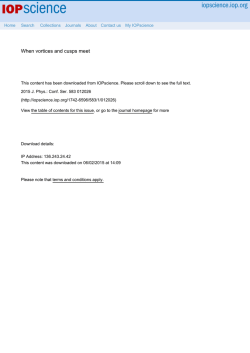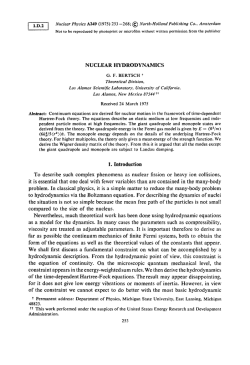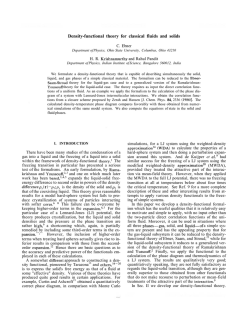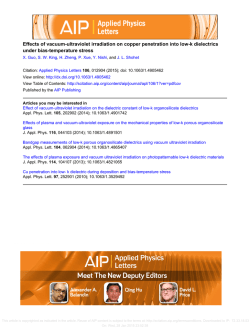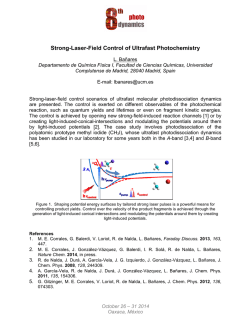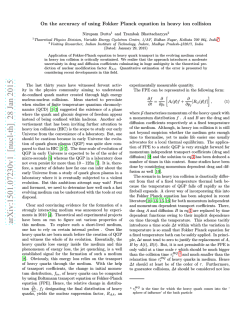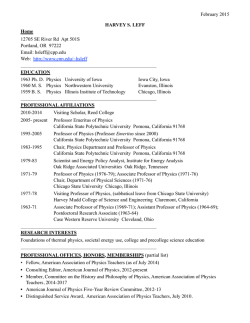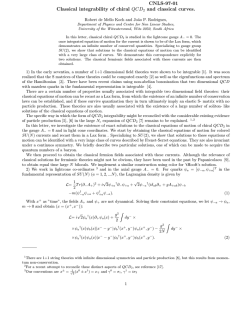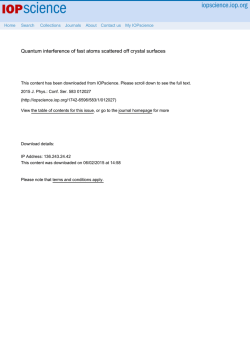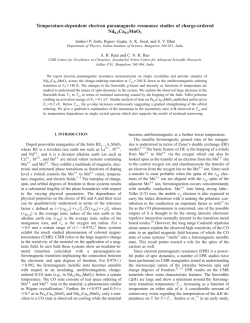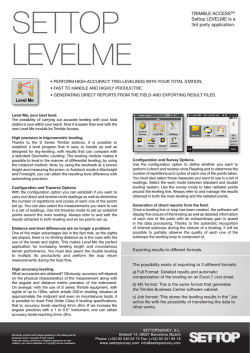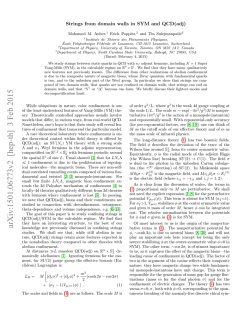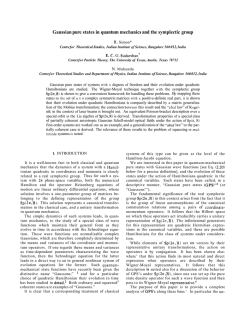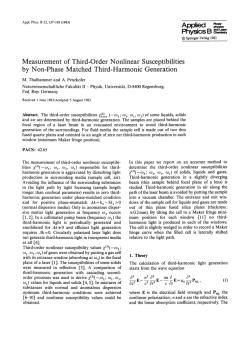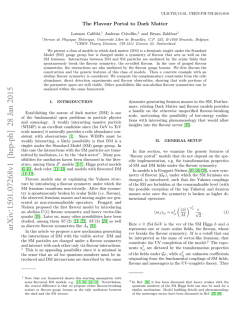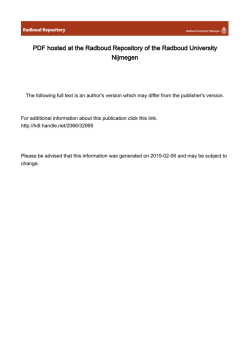
Photoelectron angular distributions from laser-excited
J. Phys. B: At. Mol. Opt. Phys. 23 (1990) L629-L635. Printed in the U K
LETTER TO THE EDITOR
Photoelectron angular distributions from laser-excited aligned
Yb atoms ionized by vacuum ultraviolet radiation
C Kerling, N Bowering and U Heinzmann
Fritz-Haber-Institut der MPG, D-1000 Berlin 33, Federal Republic of Germany
and
Fakultat fur Physik, Universitat Bielefeld, D-4800Bielefeld 1, Federal Republic of Germany
Received 8 June 1990
Abstract. Using linearly polarized Ar I line radiation for ionization, the energy- and
angle-resolved photoemission from cw-laser-excited aligned Yb atoms in the (6s6p) 3P,
state is studied. Photoelectron angular distributions have been measured for different
orientations of the laser polarization vector relative to the polarization vector of the ionizing
radiation. From polynomial fit coefficients for these distributions the ratio of reduced dipole
matrix elements and the phaseshift difference for the transitions 6 p + E S and 6 p + Ed have
been obtained at a photoelectron energy of 7.8 eV.
In order to approach a complete description of the atomic photoionization process
and to gain experimental access to the relevant dipole transition matrix elements and
phaseshift differences it is necessary to acquire information exceeding total cross section
data. For single-photon ionization of atoms in isotropic initial states the angular
distribution of the photoelectron emission is described by the second Legendre polynomial and only a single asymmetry parameter p (Yang 1948). Further experimental
information necessary for a more detailed description has to be gained from spin
polarization measurements of the photoelectrons (Heinzmann 1980, Heckenkamp et
a1 1986, Svensson et al 1988) or from photoion alignment as measured from the
polarization or angular distribution of the fluorescence radiation (Kronast et a1 1986,
JimCnez-Mier et a1 1986) or via Auger electron angular distribution (Southworth et a1
1983, Hausmann et a1 1988). For photoionization of polarized initial states, however,
the description of the photoelectron angular distribution is more complex involving
associated Legendre polynomials of higher order and containing several independent
parameters which yield additional-and in some cases complete-dynamical information without requiring spin polarization analysis. A general theoretical expression for
photoelectron angular distributions from polarized atoms was given by Klar and
Kleinpoppen (1982). Such experiments can be performed in a two-step process in
which a polarized state is prepared via resonant laser excitation and subsequently
ionized. Up to now, photoelectron angular distributions from laser-excited states have
been investigated only in several atomic systems where visible or ultraviolet laser
radiation could still be used for ionization (Hansen et al 1980, Chien et a1 1983, Siege1
et a1 1983, Mullins et al 1985).
In this letter, we present photoelectron distributions from a selectively laser-excited
state using-in contrast-vacuum ultraviolet (vuv) radiation for photoionization. In
0953-4075/90/200629 +07%03.50 @ 1990 IOP Publishing Ltd
L629
L630
Letter to the Editor
this way, the photon energy range can be extended to regions well above the ionization
threshold. In the last decade, the combination of c w laser excitation and ionization
by vuv synchrotron radiation for the study of various metal atoms has provided a
wealth of detailed spectroscopic information on excited atomic states with respect to
resonant photoionization and partial cross section (Bizau et al 1985, 1986, Preses et
al 1985, Nunnemann et al 1985, Cubaynes et al 1989). In particular, Meyer et a1 (1987)
varied the alignment of the excited state (by changing the laser polarization direction
or by selecting a different fine-structure component of this state) to study and classify
core-excited autoionizing states. However, information on both dipole matrix elements
and phases could not be extracted from these measurements, since for intensity reasons
these experiments were all performed with angle-integrated collection of the photoelectrons. Here, we describe angle-resolved studies of non-resonant photoemission from
optically aligned target atoms using linearly polarized vuv line radiation from an
intense discharge lamp. Likewise, intense synchrotron radiation could be used for
similar experiments; measurements at distinct photon energies for resonant ionization
by Zimmermann and co-workers (Zimmermann 1990) are in progress.
In our experiment, counterpropagating beams of linearly polarized laser and vuv
radiation are used while fluorescence radiation and photoelectron emission is observed
in a perpendicular direction. The set-up is represented schematically in figure 1. A
boron nitride crucible is resistively heated to about 900 K to produce an effusive atomic
beam of Yb with a density of about l o i 2atoms/cm3 in the interaction region. The Yb
atoms in the (6s)' 'So ground state are excited to (6s6p) 3P, by use of an actively
stabilized single-mode ring dye laser at A = 555.8 nm (typical output power: 300 mW).
The direction of the linear polarization of the laser (degree of polarization P 1.0)
can be rotated with a Fresnel rhomb. Although Doppler broadening results in an
effective linewidth of the transition of about 850 MHz, the isotope and hyperfine
structure of the transition (Schuler and Korsching 1938) was resolved. This enabled
selective excitation of the i ~ o t o p e s * ' ~ ~which
Y b are most abundant (-32%) in natural
ytterbium. The resonance transition was saturated and we expect the fraction of excited
atoms to be close to the limit of 16%. The fluorescence emitted from the excitation
region centred -3.3 mm above the molybdenum nozzle of the furnace was imaged
onto a photodiode using a lens and an aperture.
For photoionization, a capillary discharge lamp (Schonhense and Heinzmann 1983)
was operated with argon producing vuv line radiation at photon energies of 11.63 and
11.83 eV (Ar Ia and Ar rb, respectively). In order to record the photoelectron angular
distribution, the vuv radiation is linearly polarized by a rotatable three-mirror reflecting
-
SPECTROMETER
ELECTRON
t
APERTURE
ROTATABLE
REFLECTING
-L-LENS
POLARIZER
6
PHOTOOIOOE
Figure 1. Experimental set-up for measurements of photoelectron angular distributions
and excited-state fluorescence.
L631
Letter to the Editor
polarizer (Hancock and Samson 1976) and the polarization vector is rotated relative
to the detection direction of the electrons. With the method of Rabinovitch et a1 (1965),
the degree of linear polarization was measured to be P = 0.91 at typical intensities of
some 10" photons/s. Although the vuv lamp was operated with higher intensity at
the helium resonance line the experiments reported here were carried out with argon
rb due to the much higher 6p photoionization cross section at this photon energy.
Photoelectrons emitted perpendicularly to the photon beams in an electric- and
magnetic-field-free region were energy-analysed with a simulated hemispherical spectrometer (Jost 1979) operated with a constant pass energy of 3.5 eV, at 100 meV
resolution and with *5' angular acceptance and detected by a channeltron. Keeping
the electron analyser fixed and rotating Evuvhas the advantage that the source volume
viewed by the spectrometer does not change provided the vuv polarizer is adjusted
sufficiently well to avoid any displacement or deviation of the outgoing beam during
rotation. The adjustment was done with the help of a helium-neon laser.
In our experiment, the direction of the electric vectors ELand Evuvof both linearly
polarised photon beams can be varied. The angle 0 between Evuvand the electron
detection direction describes the photoelectron angular distribution. For completely
linearly polarized light under our geometric conditions, the photoelectron angular
distribution can be expressed in terms of associated Legendre polynomiais and five
independent coefficients (Hansen et a1 1980):
I ( @ )= (Yo,+ (Y~OP2O(cos0)f (Y4OP4O(cos0)+ (Y2IP2I(cOs0)-k (Y41P41(cos0).
(1)
Thus, four coefficients ark=
can be determined from an angular distribution
in relative measurements. These coefficients depend on the phase angle 77 between the
two electric vectors EL and Evuv.Therefore the angular dependence is recorded
preferentially by rotating both vectors simultaneously at constant phase angle. In
general, the angular distribution depends not only on the transition matrix elements
but also on the alignment of the laser-excited state as well as the degree of polarization
of the light beams.
atoms can in principle
The transition 'So+ 3P1for preparation of the excited
provide complete optical alignment, since only the (m,= 0) sublevel of the excited
state is populated with linearly polarized light. However, at the relatively high target
densities needed for observation of photoelectrons from the laser-excited state a
depolarization due to radiation trapping and collisions of excited atoms occurs (Fischer
and Hertel 1982). The effective alignment A was determined from the angular dependence of the resonance fluorescence at 555.8 nm measured with the photodiode while
rotating the laser polarization direction (geometry c of Fischer and Hertel 1982)".
In the experiments reported here we have examined the process:
Yb*(6s6p) 3P1+ hvvuv
+
[%+(6S) 2s1,2+e-(%/2,
4 / 2 9 4 , 2 ) 1
J = 0, 1,2.
(2)
The ionization potential for excited Yb3P, is 4.02eV (Martin et a1 1978). We have
recorded photoelectron angular distributions at different phase angles with Ar Ib
radiation for photoelectrons with a kinetic energy of 7.81 eV. The distribution for
parallel electric vectors has already been reported (Kerling et a1 1989). Figure 2 shows
t We use the definition A = a g h / F ( F + l), where aEhis the alignment parameter of Fischer and Hertel(l982)
and F denotes the total angular momentum including the nuclear spin. For F = 1, the alignment A is related
to the state multipole moments pi according to: A = p 2 / ( f i po).
L632
Letter to the Editor
6
5
.
;iiL
23
-8 2
a
U
1
0
Figure 2. Angular distributions obtained at phase angles 7 of 0, 30, 60, and 90". The data
points are corrected for the background count rate (typically 0.5 s-I). The full curves
originate from least-squares fits to the data. The corresponding polynomial fit coefficients
and also the alignment A (as obtained from fluorescence measurements) are given in the
figures.
typical results obtained at four values of r] by measuring the photoelectron intensity
at intervals of 15" while rotating the polarization vectors of both laser and vuv beams
synchronously. In each case, the corresponding effective target alignment was determined by recording the angular dependence of the fluorescence radiation simultaneously. Least-squares fits according to equation (1) to the data points yielded the
polynomial coefficients aik for each distribution.
When the electric vectors EL and Evuvare parallel or perpendicular to each other
the distributions are symmetric with respect to 0 = 90" (see also equation (3) below).
In these cases the fit coefficients a,, and a41are almost zero within the experimental
error, as required. However, at other phase angles r] all four fit coefficients are distinctly
different from zero and this symmetry disappears since now also odd functions involving
terms containing sin 0 cos 0 contribute. The shape of the angular distributions was
found to be very sensitive to the degree of target alignment; distributions corresponding
to higher alignment were more pronounced, because contributions from polynomials
other than P 2 , ( 0 ) increase in relative strength. As r] is increased from 0" to 90" a,,
becomes larger and a40 changes its sign. At r] = 90" a,, and a4, have equal sign and
the spatial electron emission pattern is narrowest. Our angular distributions for a
distinct angle rl resemble the corresponding distributions of Hansen et a1 (1980) and
Siege1 et a1 (1983) for r] +90". The reason for this phaseshift of 90" is that in our case
of excited Yb 3P1the 6p electronic orbital is aligned perpendicular to the laser polarization vector while in their cases the excited electron orbital is aligned parallel to EL.
As discussed by Klar and Kleinpoppen (1982), the dipole transition matrix elements
and their relative phases can be extracted from the measured photoelectron angular
distributions. We have applied their general formalism (equations (28-32) of Mar and
Kleinpoppen 1982) to the state 174Yb
3P,, (nuclear spin I = 0) for the case of the
detection geometry of figure 1 and for ionization with linearly polarized light. As an
L633
Letter to the Editor
extension, the equations were modified to include partially polarized vuv light. The
angular distributions (see equation ( 1 ) ) are then described in terms of the angles 0
and q, the alignment A of the excited state, the degree of vuv polarization P, and
several anisotropy coefficients B. In our case, six B coefficients are relevant. They are
functions of five transition matrix elements and four relative phases (cf equation ( 3 1 )
of Klar and Kleinpoppen 1982).
In order to simplify this rather complicated dependence and to obtain an approximate solution for the matrix elements as a first step, we have replaced these manyelectron matrix elements by non-relativistic single-electron matrix elements for the
transition of the excited 6p electron to E S and Ed continuum states. To that end the
excited state was described in j j coupling of the 6p electron with the core and it was
assumed that the core angular momentum remains fixed during the ionization process.
In addition, the spin-orbit interaction in the continuum was neglected, i.e. the spin of
the electron was uncoupled. However, we take explicitly into account a singlet admixture to the excited state by expanding its wavefunction in terms of pure singlet and
triplet state wavefunctions with normalized coefficients a and p and introducing the
abbreviation y = a 2- 2 p 2 . For Yb 3 P l , from the tables of Martin et al (1978) we find
y = 0.94. The six relevant anisotropy coefficients then depend only on the transition
amplitudes D, and Dd of the reduced dipole matrix elements (outgoing E S and Ed
waves), their phaseshift difference A and the singlet-triplet mixture coefficient y.
Introducing the constant C (which includes the population density of the laser-excited
state), we then derive the following equations for the polynomial coefficients a i k :
+ 2( 1 + 3 P COS 2 ~ ) y A l D+;(5 - P ) [ 2+&(5
a00 = & C { [ 8
- d ( 1 - P ) [ 4 + ( 1 -3
- 3 COS 2q)yAI 0:
COS 2T)yA]D,DdCOS
a2o=dC{[2P+i$(7P+21COS 27)-18P
COS
A}
(3a)
2qyAIDi
- d [ 4 P + ( P + 3 C O S ~ ~ ) ~ A ] D , DA ~
} COS
(3b)
aYz1
= +C[&(7- 3 P ) sin 277 yADi - d sin 277 yAD,Dd cos A ]
a40 =
~ C cos
P 277 y
a 4 ]= &CP sin 277
~
~
(3c)
:
(34
y ~ ~ Z , .
(3e)
For the special case P = 1, these equations correspond to equation ( 3 ) of Hansen et
a1 (1980) (if yA is replaced by their alignment parameter). From these equations and
the experimental results for the normalized polynomial coefficients aik and the corresponding alignment A, one can determine (D,/ Dd)2and the product D,/ Dd cos A ; i.e.
except for the sign, the ratio of the transition amplitudes D,/ Dd and the cosine of the
phaseshift difference A can be obtained. In principle, the data from a single angular
distribution are sufficient for this analysis. We have therefore evaluated each distribution
and a 4 0 / aooand solving for the two unknown
separately by forming the ratios cyz0/
quantities in these two equations. (For the data at q = 30" and 60", in addition, the
ratio a Z 1 / was used yielding consistent information.) The values determined agreed
within the experimental errors. This proved the consistency of the data obtained at
different degrees of alignment and different phase angles q and also served to increase
the accuracy of the values extracted. The average of the results from seven different
distributions are:
D,/ Dd
COS
A = -0.44
f 0.05
and
(D,/
Dd)'
= 0.28
* 0.07
(4)
L634
Letter to the Editor
yielding
(5)
lcos AI =0.83*0.14.
From equations (4) we can also derive an asymmetry parameter p of 1.75 0.15 for
direct ionization of unpolarized '74Yb(6s6p)3P1.
Our results show that the amplitude
of the Ed partial wave dominates; this is reasonable because photoionization occurs
several eV above threshold. The results (4) do not yield complete information on the
photoionization process, since at this point the corresponding absolute cross section
and the sign of cos A are not known. Our evaluation gives an approximate solution in
which the non-relativistic treatment of the photoionization process is most likely the
limiting step (see also Svensson et al 1988). Nevertheless, the results restrict the range
of values for the matrix elements involved. Theoretical calculations are not available
up to now for comparison with these experimental data.
The experiment described here represents a first step in vuv photoionization towards
a complete analysis of the atomic ionization process in terms of transition amplitudes
and phases from measurements of the photoelectron angular distribution alone.
Although vuv radiation from a discharge lamp and not laser radiation is used for
ionization, sufficiently high count rates can be achieved for non-resonant angle-resolved
studies. Angular distribution coefficients and dipole matrix elements extracted from
similar measurements in an extended vuv photon energy range will certainly be of
interest for investigations of excited-state photoionization and future developments in
related theoretical studies. In addition, our experiment opens the way to study electron
correlations in vuv inner-shell ionization through the modification of the angular
distribution due to laser excitation in the outer electron shell.
*
The authors are indebted to Professor A M Bradshaw for his encouragement, his
generous support and the hospitality at the Fritz-Haber Institut. We would like to
thank H Kerkhoff for his assistance with the computer fit program. Financial support
by Deutsche Forschungsgemeinschaft (SfB 161, 216) and Bundesministerium fur
Forschung und Technologie (under contract 0533 1 AXI) is gratefully acknowledged.
References
Bizau J M, Cubaynes D, GCrard P, Wuilleumier F J, PicquC J L, Ederer D L, CarrC B and Wendin G 1986
Phys. Rev. Lett. 57 306-9
Bizau J M, Wuilleumier F J, Ederer D L, Keller J C, Le Gouet J L, PicquC J L, CarrC B and Koch P 1985
Phys. Rev. Lett. 55 1281-4
Chien R-L, Mullins 0 C and Berry R S 1983 Phys. Rev. A 28 2078-84
Cubaynes D, Bizau J M, Wuilleumier F J, CarrC B and Gounaund F 1989 Phys. Rev. Lett. 63 2460-3
Fischer A and Hertel I V 1982 Z. Phys. A 304 103-17
Hancock W H and Samson J A R 1976 J. Electron Spectrosc. Relat. Phenom. 9 211-6
Hansen J C, Duncanson J A Jr, Chien R-L and Berry R S 1980 Phys. Rev. A 21 222-33
Hausmann A, Kammerling B, Kossmann H and Schmidt V 1988 Phys. Rev. Lett. 61 2669-72
Heckenkamp Ch, Schafers F, Schonhense G and Heinzmann U 1986 Z.Phys. D 2 257-74
Heinzmann U 1980 J. Phys. B: At. Mol. Phys. 13 4353-66,4367-81
JimCnez-Mier J, Caldwell C D and Ederer D L 1986 Phys. Rev. Lett. 57 2260-3
Jost K 1979 J. Phys. E: Sci. Instrum. 12 1001-5, 1006-12
Kerling C, Bowering N and Heinzmann U 1989 Proc. 16th Int. ConJ on the Physics ofElectronic and Atomic
Collisions ( N e w York) ed A Dalgarno, R S Freund, M S Lube11 and T B Lucatorto (Amsterdam:
North-Holland) Abstracts p 9
Klar H and Kleinpoppen H 1982 J. Phys. E: At. Mol. Phys. 15 933-50
Letter to the Editor
L635
Kronast W, Huster R and Mehlhorn W 1986 Z. Phys. D 2 285-96
Martin W C, Zalubas R and Hagan L 1978 Afomic Energy Levels--The Rare-Earth Elements NSRDS-NBS
60 (Washington, DC: US Govt Printing Office) p 378
Meyer M, Muller B, Nunnemann A, Prescher Th, von Raven M, Schmidt M, Sonntag B and Zimmermann
P 1987 Phys. Rev. Lett. 59 2963-6
Mullins 0 C, Chien R-L, Hunter J E 111, Keller J S and Berry R S 1985 Phys. Rev. A 31 321-8
Nunnemann A, Prescher Th, Richter M, Schmidt M, Sonntag B, Wetzel H E and Zimmermann P 1985
J. Phys. B: At. Mol. Phys. 18 337-41
Preses J M, Burkhardt C E, Corey R L, Earsom D L, Daulton T L, Carver W P, Leventhal J J, Msezane
A Z and Manson S T 1985 Phys. Rev. A 32 1264-6
Rabinovitch K, Canfield L R and Madden R P 1965 Appl. Opt. 4 1005-10
Schonhense G and Heinzmann U 1983 J. Phys. E: Sci. Instrum. 16 74-82
Schiiler H and Korsching H 1938 Z. Phys. 111 386-90
Siege1 A, Ganz J, BuBert W and Hotop H 1983 J. Phys. B: At. Mol. Phys. 16 2945-59
Southworth S, Becker U, Truesdale C M, Kobrin P H, Lindle D W, Owaki S and Shirley D 1983 Phys. Rev.
A 28 261-79
Svensson A, Muller M, Bowering N, Heinzmann U, Radojevic V and Wijesundera W 1988 J. Phys. B: At.
Mol. Opt. Phys. 21 179-85
Yang C N 1948 Phys. Rev. 14 764-72
Zimmermann P 1990 Invited Talk DPG meeting Munchen
© Copyright 2026
